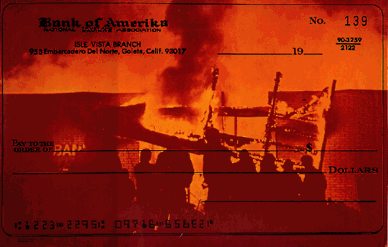|
Chapter summaries
|
Online Chapter: Peace Symbols: Posters in Movements against the Wars in Vietnam and IraqMoratorium Time: A General Strike for PeaceBy the late 1960s, driven by constant antiwar activity and aided by daily images of war on the nightly television news, many in mainstream America began to believe that the war was a mistake. As with the later war in Iraq, those who saw the war as no mistake, but rather as a conscious part of a larger, devastating policy of intentional imperial militarism, were often frustrated by this more superficial criticism of the war. But the need to stop its horrendous destruction was paramount. Throughout the middle years of the decade, various fragile coalitions with names like the National Mobilization to End the War in Vietnam (MOBE, for short) emerged, died, and reemerged as they sought to hold a mass movement together across ideological, class, and racial lines. Those tensions became even more palpable in the late 1960s as tactics became more aggressive, but at the same time the absolute numbers of antiwar forces continued to grow. The year 1968 was one of the most tumultuous in U.S. history, with a president driven from office (Johnson declined to run again when faced with antiwar primary candidates in his own Democratic Party), the assassinations of Martin Luther King Jr. and Robert Kennedy, race riots in over one hundred American cities, student strikes on dozens of campuses, a “police riot” at the Democratic convention, and incessant protests against war, racism, and poverty. The exhilaration felt as antiwar candidates McCarthy and Kennedy emerged gave way to despair as the latter was assassinated and the former outmaneuvered for the nomination by business-as-usual candidate Hubert Humphrey. Humphrey’s lackluster campaign led to the election of Republican Richard Nixon, whose “secret plan” to end the war turned out to be a plan to bomb the country into the Stone Age while withdrawing enough U.S. forces to give the appearance of winding down the conflict. The strategy devised to bring the antiwar movement to a new level of popularity, visibility, and effectiveness was a kind of national general strike known as the Vietnam Moratorium. The idea was brilliantly simple: set aside one day a month as a day to stop all “business as usual” to concentrate on ending the war. The moratorium led to the largest day of antiwar protest to that date. Building on, expanding, and spawning new groups based in various occupations—Computer Professionals Against the War, Teachers Against War, Teamsters for Peace, and so on—the strategy allowed for multiple levels of commitment and a variety of kinds of protest, from the very safe to the dangerously disobedient. While the leaders of various factions continued to squabble, and the gap between moderate, liberal, and radical strands widened, the moratorium idea signaled the rise of a majority-backed movement and propelled a gradual winding down of the war. Just as antiwar forces had grown in proportion to the number of U.S. soldiers in Vietnam, the antiwar movement gradually subsided as the troops were slowly withdrawn when and as Nixon claimed he was turning the war over to the South Vietnamese. In fact, Nixon secretly and illegally carried the war over into Cambodia, in a move that helped bring to power the mass murderer Pol Pot.9 The Cambodia incursion led to one of the last major bursts of protest in the spring of 1970, which saw the shooting of unarmed students at Kent State University in Ohio and Jackson State University in Mississippi. The spirit of those protests is captured in “Bank of Amerika Isla Vista Branch” (Figure 24), a parody of a check that pictures the flames rising from the Isle Vista branch of the bank in Santa Barbara, California, which was burned to the ground in protest of the war and the deaths of student protesters.
Figure 24. “Bank of Amerika Isla Vista Branch,” Metamorphosis, 1970. Courtesy of Sixties Project. Over the next several years the threat of renewed antiwar protests restrained the Nixon administration and forced Nixon and his successor Gerald Ford to actually deescalate the war. While that process took several more years, complicated by the Watergate affair that drove Nixon to resign, the movement had by 1970 made it effectively impossible to expand the war or continue it at the same level. Only winding down remained. 9. The story of the devastating impact of U.S. incursions into Cambodia is detailed in William Shawcross, Sideshow: Kissinger, Nixon, and the Destruction of Cambodia (New York: Simon and Schuster, 1979). |
|||

